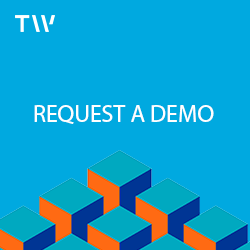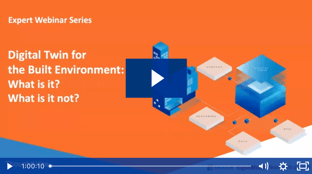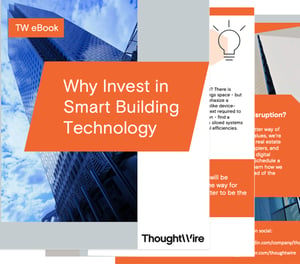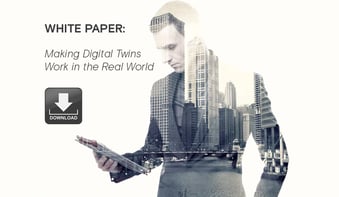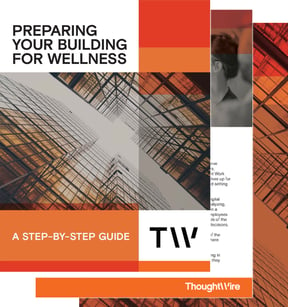Recently, we hosted a webinar with industry experts, Paul M. Maximuk from Newcomb & Boyd, Emmanuel Daniel from Microsoft, and Charles Whiteley from ExxonMobil. Below is part one of three excerpts from our expert Q&A where we will be discussing various themes. In theme one, our experts discuss everything that is and is not a Digital Twin.
Read, listen or watch the Q&A discussion below:
Q: What is a Digital Twin from your perspective?
A: Emmanuel: For me, when we start talking about a Digital Twin aligned to the physical technology and the physical space, it’s about merging both the digital and the physical worlds. So, what that means is one, a visualization of that building which will look exactly how the building looks. And two, is merging that data to the physical space so that I know what’s happening in that physical space, and use that data to drive intelligence and take preemptive actions rather than reactive actions. So merging a 3D visual model combined with a data model of that building, and bringing it together to drive intelligence is what is a digital twin from my perspective.
A: Charles: Not to knock the terminology, I think the terminology makes sense for different individuals or organizations in different stages of their transformation journeys. But, ExxonMobil is a very large oil and gas company, and our commercial real estate (CRE) group is a subset of that broader organization. The term Digital Twin (at least in the oil and gas space) has a connotation tied to process controls and process controls environment. It’s very different to how it's being used in the CRE space. From our perspective, we took a slightly different approach than most. Instead of leveraging BIM as a foundation for our Digital Twin, we really focused on enterprise architecture approach, as well as, defining and implementing a meta model that focuses on business services, technology and functional services, and hardware.
Our experience in due diligence in regard to BIM, revealed to us that at this point in time, it’s very much cost prohibitive from an upkeep and maintenance perspective. Standards are still very much disjointed across functional disciplines in our global contractor base. We approached it from a pure IoT platform perspective. It really focused on the data elements, the hardware elements, the key strategic business objectives we wanted to enable, and really allowed us to maintain modularity in regard to loosely and tightly coupled service enablement that enable delivery of a multitude of use cases we would want to deliver. It’s been a couple of years since we’ve been on this journey. Organizations like ThoughtWire and other technology providers out there have really matured in the space. But, when we started our journey two and a half years ago, we felt that existing platforms and/or existing products really missed the mark in terms of tying the technology to business outcomes, business enablement, hard ROI, and hard benefits. This is what really gets our organization excited, and it’s the only way we can fund these types of technology investments and/or projects.
Q: From your perspective as a consultant, what are some of the most important things a company should be considering when they’re looking to go down the path of Digital Twin?
A: Paul: The first and most important thing is they bring the right people to the table to understand what their true vision is. And a lot of the clients we work with started a master plan, had a master plan in technology, or haven’t even thought about it yet. Some key things that we look at and work with our clients on are where do they want to start? What are their problem areas? What are the problems they are trying to solve? So, working with them on those use cases helps develop where a Digital Twin model will go. Looking at most of the systems that we see out there now, everybody has some type of BMS/BAS system, an energy monitoring system, or a CMS system - all these different diverse systems, but nothing is connected. Looking at bringing those technologies altogether, in addition to adding other technologies into the space that will bring data that are usable for that customer/client, and make sense of integrating all those systems into this Digital Twin.
Q: Who are some of the people that need to be in the room when making big consultant decisions?
A: Paul: Definitely the operations team is where this starts. Part of the key success of this is having a champion to drive the operational side. Second, you bring the IT folks in if they’re not in at the beginning of the conversation and brought in at a later date. There is crucial input from them that will help make this a huge success or a total failure. And from the IT teams, you’ll be bringing in the networking teams, the cybersecurity teams, you’ll be bringing solution architects into the picture, and then you bring in the space planning teams and the construction planning teams as well. This is because this has to be thought out through all these different groups. If it is not, nobody will be aligned and then the delivery will not be successful.
Q: What are some lessons you learned over the process of implementing your ecosystem architecture at ExxonMobil’s campus in Houston?
A: Charles: If I was to take a step back and think about some things we may have done a little differently, early on, I would have delineated between greenfield requirements and brownfield requirements straight out the gate. From an IoT perspective and a data aggregation perspective, a lot of the older sights require significant investment both in hardware and potential monetization of mechanical versus digital type control systems within their physical environment. I would have delineated up front greenfield design versus brownfield limitation plans. One of the other things that I think we would have started earlier rather than later: we had done significant work tied to our meta-model of how all the pieces of the IoT platform work together. We probably would have come out of the gate, looking at standards, defining standards tied to BACnet, and Modbus endpoints that were consuming and pulling in from a BMS perspective. That ended up being probably the second or third thing that we did out the gate. But, what ended up happening is that we had a couple of sites coming online that we missed out on that opportunity to standardize those BMS and BACnet/Modbus endpoints from a commissioning perspective. And, we lost opportunity on our side of things.
We defined a couple of key drivers/levers in regard to how investments in Digital Twin and IoT smart building technology could have an impact on our business. First and foremost is energy savings. You look at HVAC systems within a built environment, typically HVAC and lighting are your biggest energy pulls. Thirty percent on average is an ideal state. The identification of the standards allowed us to look at the commissioning process of a new build, and I think it’s something that most organizations don’t think about, or miss out on. When you go through fault rationalization, alarm rationalization over time, and work with companies (mechanical companies and engineering firms), to get your building into a peak operational efficiency state, there’s a lot of investment. There’s a lot of dedicated teams on the ground, a lot of tweaking/modifying the way you’ve set up or commissioned that building. For us on average, we’re looking at 3-5 years, depending on the size of the site. The standards work upfront has now allowed us to focus on a new target of 18 months to peak operational efficiency. So, focusing on the platform first and the meta-model and the enterprise architecture was an exercise that will pay dividends long term. But, I think we could have added value at a much more accelerated rate if we had focused on the standards, and then built lightweight applications tied to a historian to further validate the business case.
Q: What does Digital Twins of Digital Twins mean?
A: Emmanuel: When you start with a Digital Twin the utmost important thing is the quality of data tied to the impact that you would like to deliver. Be it operational impact, experience impact, or be it effectiveness of the space that you’re going to provide for your occupants. Now to be able to do that in a space, you’ve got multiple systems that are running. You start with a space and a space is supported by multiple systems, and not everybody knows that to get an ambient environment in a physical space you’ve got BMS’s, HVACs, lighting systems, access systems. All of this coming together to create an experience that is operationally viable for the organization. Now in that case, if you take a transportation system like an elevator - how will transportation systems run? What type of data do they share? Many of the organizations today have got places where they start talking about shared services or maintenance contracts. In those cases, manufacturers will always still know the performance and operations of their critical assets. And in that case, what data does the landlord need to know and consume? - And that’s where the Digital Twins of Digital Twins start to come in.
For one, the manufacturer or the owner of the asset of the product tries to understand how the asset is functioning, how it’s performing, and the maintenance style. They then use that data to then share with the owner or the landlord of that property to say that hey, this is how your asset is performing. And they use snippets of that data to understand- is the floor of people going through the building happening correctly? Are the intervals correct? Are the elevators where they need to be at that given point and time? And this concept applies to all of the assets that you have. The same thing goes for lighting and would apply for parking. And that’s why in a physical space, or on a campus, or in a city, Digital Twins of Digital Twins start to set in where everything is a replica of itself, is optimized, fine-tuned, and efficient.
You share data with other systems that those systems need to drive that efficiency, and drive that experience. Without that communication, without that standardization, or that meta-model definition, this wouldn’t work. And that’s why the definition of data is the foundation of the creation of the Digital Twins of Digital Twins.
Q: What do you think the trending for Digital Twins is going to be? Do you see Digital Twin continuing to grow? Do you see this as becoming a standard in the commercial corporate real estate world?
A: Paul: I think we’re going to see an increase in Digital Twins over the next five years. It's an early adaptation to it, a lot of the organizations are starting to see how disparate their systems are. They want to bring all this information together, they want to make it actionable, use it for decision points, use it for management of devices. And I would say, if you look at the different terminology said before in your previous discussion about MSI or single painted glass view, this represents what a lot of companies are looking for nowadays. They want to bring all these different systems together and make them actionable for the data.
Q: Have you engaged a consultant firm to assist you in the Digital Twin journey?
A: Kyle: I’ve had the pleasure of working with a number of different consultant firms, AEC’s MSI’s, MEP firms, and I see different levels of sophistication with the consultant firms just as well as seeing different levels of sophistication at the client level. There are consultant firms out there that are investing a heavy amount of time in understanding this next generation of the data model in Digital Twin so that they can provide that insight and guidance to the client. I would encourage any organization that is looking at going down this journey to do a very thorough vetting of the AEC or the consultant firm that you’re going to be working/partnering with. It’s not necessarily the biggest firms out there who have the most expertise around Digital Twin technology for the built environment. Some mid-size and smaller boutique shops have invested heavily in spending time with companies like ThoughtWire and other Digital Twin technology providers that are in the market. I would recommend trying to gain some understanding of the smart building projects that they have completed and understand how they are speaking to the concept/vision. Are they starting with the technology? Your employees? Your tenants? The people - the customer? And then building back into what technology you need to enable it. A critical piece of this again is the data. Do they have a strategy of how they’re going to get that data in one spot, normalize it, and then enable you to have an ecosystem that’s flexible enough to absorb that data to achieve those outcomes, and those use cases that you’re trying to put together as an organization?
A: Emmanuel: The confusion with Digital Twins today is people believe that creating a model of anything will magically deliver value. One, it can be a 3D model visualization, or a beautiful dashboard showing what the building looks like, and you get value-driving out of it. And that is not accurately true. The true value comes only when you are able to merge the operations side along with the experience side. There has to be benefits both for the occupant and for the owner, or for the service provider which is the FM manager in this case. And how is Digital Twin going to enable that? - And that is where the true value of Digital Twin starts to fit in. Now, if we are focused on only one side of it which is creating a 3D representation of that building, or we focus on the other side which is just collecting and gathering data (and you know buildings have thousands of data points coming out of them), it doesn’t drive the value towards better experiences or higher efficiency. Bringing these two together is what is going to allow for the true value of Digital Twins to come out. And standardizing it in terms of how devices communicate, how they exchange data, and what is going to be used to drive the experiences and efficiencies. - It is going to be the key to ensure Digital Twin actually delivers the value that it is promising to deliver.
As an organization that serves many industries such as healthcare, commercial real estate, and corporate real estate organizations, we empathize deeply with what our customers are going through at this moment. We’re a technology organization, but for us people have always come first. If you need advice on where to start or how you can make the changes your organization needs to be prepared for the future, get in touch. Community is important now more than ever.

